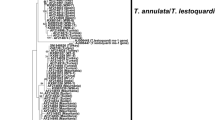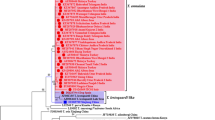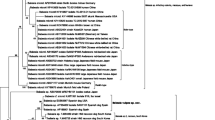Abstract.
Theileria parasites known as either T. buffeli, T. orientalis or T. sergenti share many characteristics and are referred to as the T. buffeli group. The 18S ribosomal RNA and merozoite-piroplasm surface protein-encoding genes display a wider genetic variation within the T. buffeli group than between well defined species like T. annulata and T. parva. Analysis of 18S rRNA gene sequences from the database showed that similar groups of related Theileria parasites occur in wild ruminants in Japan and the USA. Moreover, a recently discovered Theileria species pathogenic for small ruminants in China is phylogenetically related to these Japanese Theileria parasites. Phylogenetic analysis of all Theileria 18S rRNA genes reported thus far allowed a subdivision into eight clusters. Some of these clusters contain multiple different species, whereas others appear to contain parasites with similar biological properties whose true speciation remains at present unresolved. The consequences for 18S rRNA based diagnostic assays is discussed.
Similar content being viewed by others
Author information
Authors and Affiliations
Additional information
Electronic Publication
Rights and permissions
About this article
Cite this article
Gubbels, MJ., Yin, H., Bai, Q. et al. The phylogenetic position of the Theileria buffeli group in relation to other Theileria species. Parasitol Res 88 (Suppl 1), S28–S32 (2002). https://doi.org/10.1007/s00436-001-0566-3
Received:
Accepted:
Published:
Issue Date:
DOI: https://doi.org/10.1007/s00436-001-0566-3




